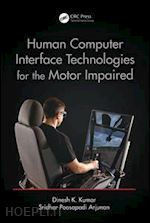Human Computer Interface Technologies for the Motor Impaired examines both the technical and social aspects of human computer interface (HCI). Written by world-class academic experts committed to improving HCI technologies for people with disabilities, this all-inclusive book explores the latest research, and offers insight into the current limitations of this field. It introduces the concept of HCI, identifies and describes the fundamentals associated with a specific technology of HCI, and provides examples for each. It also lists and highlights the different modalities (video, speech, mechanical, myoelectric, electro-oculogram, and brain-waves) that are available, and discusses their relevant applications. Easily and readily understood by researchers, engineers, clinicians, and the common layperson, the book describes a number of HCI technologies ranging from simple modification of the computer mouse and joystick to a brain–computer interface (BCI) that uses the electrical recording of the brain activity of the user. The text includes photographs or illustrations for each device, as well as references at the end of each chapter for further study. In addition, this book: Describes the mechanical sensors that are used as an interface to control a computer or screen for the aged and disabled Discusses the BCI using brain waves recorded by noninvasive electrodes to recognize the command from the user Presents the myoelectric interface for controlling devices such as the prosthetic/robotic hand Explains the technology of tracking the eye gaze using video Provides the fundamentals of voice recognition technologies for computer and machine control applications Examines a secure and voiceless method for the recognition of speech-based commands using video of lip movement Human Computer Interface Technologies for the Motor Impaired considers possible applications, discusses limitations, and presents the current research taking place in the field of HCI. Dedicated to enhancing the lives of people living with disabilities, this book aids professionals in biomedical, electronics, and computer engineering, and serves as a resource for anyone interested in the developing applications of HCI.












